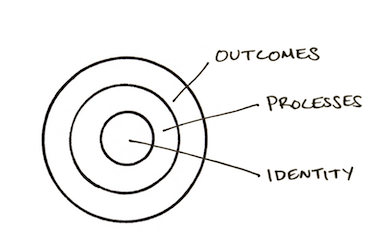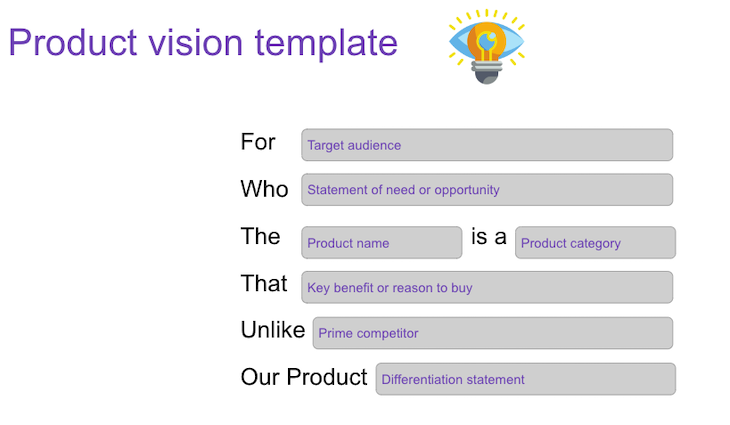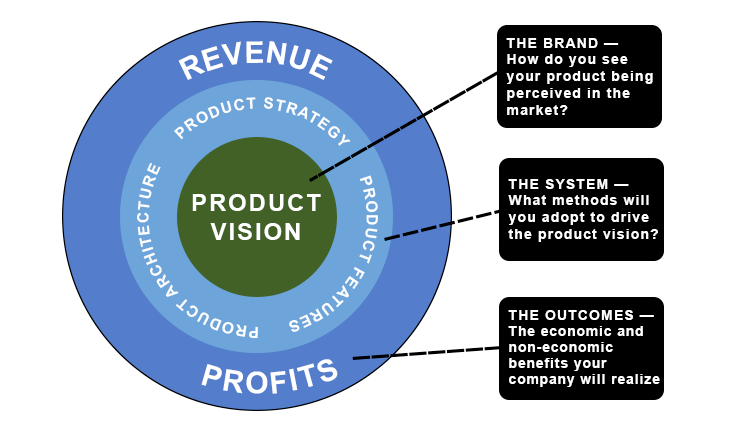Editor’s note: This article was last updated on 31 May 2023 to add:

The importance of a product vision cannot be overstated. It has a profound impact on product development, strategic decision-making, and team alignment. It provides a high-level guide to developing a better product roadmap, helps improve strategic decision-making throughout the development process, and aligns teams and stakeholders across the company.
In this guide, we’ll define what we mean by product vision, break down the components of a good vision statement, and look at some real-world examples.
A product vision, or product vision statement, describes the overarching long-term mission of your product. It’s a beacon guiding all stakeholders involved in a product’s development toward the shared objective they’re trying to achieve.
Put simply, the product vision answers the fundamental question of why you are creating a product and what your company hopes to accomplish with it in the future.
The product vision serves as the cornerstone of a company’s strategy. It is the driving force behind the product roadmap and the product strategy, giving a clear direction of where the product is headed and what it aims to achieve.
Defining your product vision and writing a product vision statement should be the first step in starting any new product’s journey and should always precede the development of the product roadmap.
Although everyone in the company should contribute insights or inspiration, the product manager should take the lead on driving the product vision statement to completion and then ensuring everyone in the organization knows it.
Think about it: Who is accountable for converging every discussion across marketing, sales, legal and engineering and, most crucially, has the best understanding of the market they serve?
The product manager must also be able to inspire their team by defining a product vision. Unlike the company vision, the product vision can be a collaborative process. Representation from multiple teams (especially R&D, sales, and marketing) is required to define a product vision quickly with a keen sense of cross-team alignment.
Product owners play a crucial role in contributing to the product vision. They serve as the bridge between the product development team and the stakeholders, including customers, business executives, and sales and marketing teams. The PO’s close involvement with all these entities provides them with a unique perspective and understanding of what the product should aim to achieve.
Product owners are responsible for defining the product features and prioritizing them based on the product vision. They help articulate the product vision in terms of user stories, requirements, and features that the development team can understand and execute. This process of translating the vision into actionable items is essential for the product to align with the company’s strategic goals.
Moreover, product owners are crucial in ensuring that the product vision remains a focal point throughout the product development process. They continually refer back to the vision to guide decision-making, manage trade-offs, and navigate changes, thereby ensuring the product stays true to its intended purpose and goals.
Lastly, product owners play a critical role in communicating the product vision to all stakeholders. They are often the ones presenting the vision and the roadmap to stakeholders, explaining how the proposed features and changes align with the vision and addressing any concerns or questions. In this way, product owners help foster understanding, alignment, and buy-in for the product vision across the organization.
A good product vision is more than just a statement; it’s a compelling narrative about the future of your product. It involves understanding the needs of your target customer, describing your product, stating its unique benefits and selling points, and differentiating it from competitors or current methods.
A product vision statement describes the long-term desired outcome for your product. The objective of a vision statement is to drive the value system by allowing everyone to engage consistently to identify ways to achieve a common goal.

A successful product vision should further break down and define the product strategy, roadmap, and features consistent with the vision statement.
A vision statement cannot be prescriptive. Furthermore, a vision statement is not about directly growing the top or bottom line. Atomic Habits, a book by James Clear, explains identity-based habits.
The ID, at the core, is like a vision statement — your brand and what others associate you with, not your revenue and profitability.
A good vision statement should enable calling out leading KPIs (for instance, run five times a week for 30 minutes) rather than trailing KPIs (lose 30 pounds). Yes, losing 30 pounds can be essential, but that is not the primary focus of a vision statement.
Now that we understand what a product vision is and who is responsible for defining it, let’s zoom in on some qualities that successful product vision statements have in common:
A vision statement must build on a solid sense of market need. In other words, it should demonstrate value creation.
For instance, if a product intends to express its solidarity toward the open source community, it must also show why that is crucial. In other words, the product’s intent is not simply to foster alignment with the open source community, but to demonstrate why the product is vital to the community it serves.
To provide context, let’s refer to the pizza store example referenced in this video:
The mission statement goes from this:
“To serve the tastiest damn pizza in Wake County”
To this:
“The highest-quality entertainment solutions to families.”
How did it go from being a pizza place to offering entertainment solutions? This mission statement is too ambitious.
At the same time, you don’t want a vision statement to become stagnant; the product vision should always be evolving. However, the basis should be a better understanding of the market or a clear opportunity to expand into a different vertical.
In other words, if your product vision aims to solve world hunger, chances are you’re overthinking it.
A well-articulated product vision needs to present a future state and express why that future state is essential to the market the product will serve.
This statement might appear as if value capture is an important theme. As a subtext, it is, because your executives need to explain the product’s value to their stakeholders.
The critical point is that your customers can view this as the light at the end of the tunnel. The team that works towards this vision finds it something worth going above and beyond for.
I’ll provide a different analogy here. We discussed the consumption model for a manufacturing solution I was responsible for. To give some context, manufacturers have several lines, and each line has multiple machines.
Two factors are essential for manufacturers. The first is the ability to forecast annual costs. The second is particularly important: understanding the pricing model quickly.
The pricing model should be something that the key stakeholders on the buyer side connect well with. For example, a reference to a line or machine would be effective because stakeholders inherently understand it.
When discussing the pricing model, my colleague said, “Let’s use sessions as a reference point.” The session he was referring to was the number of parallel sessions on the server. If were to ever try that, it would be my last such discussion with the manufacturer!
I would advise my colleague to take that back to the product vision. Treat those who work on realizing this vision as your customers. Ask yourself, can they relate to the statement?
A mission statement and a vision statement for a product are often used interchangeably, and the intent of each often is misunderstood. In actuality, the two are very distinct and they each have a clear purpose, meaning, and context.
A mission statement serves to talk about why the product is built and what objective it is trying to meet. At a broad level, it can talk about the problem the product is trying to solve, for whom, and how it is solving it. The mission statement is defined in the present tense, as it tries to address what the product is trying to actively achieve.
A vision statement outlines what the product is trying to achieve in the long term. The vision is more strategic and overarching, defining what value it wants to provide the user. It’s the “why” of the product.
The vision statement is therefore a futuristic, long-term view of the company and product’s objective. Therefore, the vision statement is generally set in the future.
The table below lists the key differences between the mission and vision statement for a product:
| Vision statement | Mission statement |
| Defined in the first step of starting on product definition and development | Comes as the next step after setting the product’s vision |
| Drives the strategy of the product and is the “why” of the product | Drives the “how” of the product and how to realize the product vision |
| Defines the end goal of the product (long-term or future) | Defines the immediate goals of the product ( short- or near-term) |
| Influences the focus of the product, product roadmap, and the features to prioritize | Influences the market/customers being targeted and the development plan/processes |
| Helps align the stakeholders towards a common goal and achieve a mutual purpose | Helps perform the planning, resourcing, etc. |
Some of the world’s most successful companies have developed compelling product visions that helped align everyone on the team. These statements are powerful not only because of their conciseness but also due to their clarity of purpose and aspirational nature.
The product vision statement examples below present a clear picture of the world that the product aims to create, and every aspect of product development is aligned towards achieving this vision:
This vision statement is powerful because of its simplicity and clarity. It tells you what the product does (fill homes with music) and what its ambition is (every home). It suggests that Sonos isn’t just about selling speakers; it’s about enhancing people’s lives with music
Google’s vision statement is ambitious and speaks to its primary function – making information universally accessible and useful. This statement is a powerful expression of purpose, driving the company’s various initiatives from search to cloud storage to maps and more
Instagram’s vision statement is all about connection and sharing. It’s about capturing and sharing moments, not just images. This vision has guided Instagram’s feature development, focusing on easy photo sharing, stories, and more
Uber’s vision statement demonstrates its ambition to change the world by changing how people move within it. It’s not just about taxi rides; it’s about reshaping transportation and logistics as a whole, reflecting its expansion into areas like food delivery and freight
LinkedIn’s vision statement clearly outlines who its product is for (professionals) and the value it aims to provide (connectivity, productivity, success). It demonstrates a clear understanding of its user base and its needs
Remember, a powerful vision statement is one that resonates with both the team developing the product and the users who will benefit from it. It should inspire, motivate, and guide everyone involved in the product’s lifecycle.
Creating a product vision statement is a crucial first step in the product development process. It sets the direction and the goal post for your product. Here’s a step-by-step guide on how to create a compelling product vision:
Who are you building your product for? What are their needs, challenges, and aspirations? Understanding your target customer is essential for crafting a vision statement that resonates with them. Conduct market research, user interviews, and surveys to gather this information.
What makes your product different from the competition? What unique value does it offer to your target customers? Understanding your product’s unique value proposition will help you define a vision that’s compelling and different from what’s already out there.
Where do you want your product to be in the future? What impact do you want it to have on your customers and the world? This is the aspirational part of your vision statement. It should inspire your team and your customers.
Using the insights from the previous steps, draft your vision statement. It should be concise, clear, and compelling. Remember, it’s not meant to be a detailed description of your product but a broad and inspiring statement of your product’s purpose and direction.
For a good starting point, you can use the product vision statement template below.
Once you’ve drafted your vision statement, it’s important to test it. Share it with a few trusted team members, stakeholders, or even customers. Get their feedback. Does it resonate? Is it compelling? Use their feedback to refine your statement.
Finally, once you’re happy with your vision statement, it’s time to share it widely. It should be communicated to everyone in your organization and, where appropriate, your customers and stakeholders. Your product vision is a guiding light for your product development efforts, so it should be known and understood by all.
Remember, a product vision statement is not set in stone. As your product, market, or customers change, your vision statement may need to evolve as well. Regularly revisit your vision statement to ensure it’s still aligned with your product’s direction and your customers’ needs.
When it comes to actually writing your product vision statement, using a template as a guide can be helpful.
The template offered by Geoffry Moore in his book Crossing the Chasm is a simple fill-in-the-blank approach:
For [our target customer], who [customer’s need], the [product] is a [product category or description] that [unique benefits and selling points]. Unlike [competitors or current methods], our product [main differentiators].
This format lays out all the most important characteristics and provides clear guidance. From this, you will have a better sense of who will interact with your product and how you will carve out a market niche.
You can use this template with your team to work toward a vision statement that accurately represents the direction of the product and its customer fit:

When crafting a vision statement, imagine yourself in front of an audience (potential customers) at a conference introducing your product. Start with “We believe” and finish that statement in two to three sentences.
This concept is not unlike the famed press release from Amazon. However, the abridged version should resonate with the audience.
Creating a product vision requires domain knowledge and an inherent understanding of customer pain points and unmet needs.
In some cases, I start with a bulleted list of the pain points and categorize them into larger buckets to identify patterns. In another scenario, it was to capture a user journey and how our product fits into that story in other cases.
I have never written a product vision in a silo. I typically call a few folks from diverse backgrounds (e.g., a product architect, the product manager, the sales lead, etc.) to help craft the vision.
We spend no more than 30 minutes to an hour writing the first version. The product vision statement might go through a few more iterations as I work with my leaders. I do this because it drives consistency in understanding; everyone has skin in the game, and the vision takes an organic communication route.
There is no silver bullet to craft a perfect product vision. The closest thing I can offer is this advice: get your team together, keep it at a 10K level, and capture it in two to three sentences. Also, avoid overthinking it — the product vision statement shouldn’t take more than an hour or two, tops, to create.

Your product vision statement is your brand; your audience should associate with it. The product strategy and roadmap are methods that bring the vision alive. The eventual outcomes are the top and bottom line.
A good vision statement enables a sound product strategy. Strategy elements such as market segmentation, pricing, ecosystem partnerships, and staging (MVP to general availability) should naturally flow from the vision. It should assist with building the right set of features and, more crucially, help with features that are in direct conflict with the vision).
Using product management software can play a crucial role in defining, communicating, and implementing product vision. These tools provide product managers with a variety of methods for defining, aligning, and communicating product vision, aiding in the creation of successful and strategic products that align with their company’s long-term goals.
Some examples of popular tools that can help you craft and communicate your product vision include:
Productboard is a product management tool that provides a clear structure for product teams to understand customer needs, prioritize ideas, and make strategic decisions. It offers a unified view of feedback, research, and ideas, which can help product managers maintain alignment with the product vision and facilitate transparency in the decision-making process
Craft is a product management tool that provides a single, collaborative platform for product teams. It offers features like user story mapping, prioritization matrices, and product roadmaps.
Carft’s emphasis on real-time collaboration and agile methodology can support product managers in maintaining alignment with the product vision and facilitating communication across teams
Jira is a project management tool widely used by development teams to plan, track, and release software. It offers flexible planning tools, insightful data reports, and integrations with a multitude of other tools.
With Jira’s feature-rich platform, product managers can align the product development process with the product vision, track progress, and communicate changes effectively
Aha! is a product roadmap software that helps teams define their strategy, plan future work, and monitor progress. It provides features like strategy roadmaps, release roadmaps, and idea management.
This tool can be beneficial to product managers in aligning product strategy with the product vision, planning for future work according to the vision, and monitoring progress towards achieving the vision
ProductPlan is a cloud-based roadmap software designed for product managers. It offers features like drag and drop roadmaps, secure sharing, and integration with popular tools like Jira and Slack.
ProductPlan can help product managers communicate the product vision and strategic plan effectively across the organization, thereby ensuring alignment and consensus on the vision
The product vision is a crucial, foundational driver of product development and strategic decisions. It’s the north star guiding your product’s journey, ensuring that every step taken aligns with the ultimate goal.
Whether you’re starting from scratch or looking to refine an existing vision, a clear, compelling product vision is an essential component of successful product management.Discussion on the use of tools in defining, communicating, and implementing product vision.

LogRocket identifies friction points in the user experience so you can make informed decisions about product and design changes that must happen to hit your goals.
With LogRocket, you can understand the scope of the issues affecting your product and prioritize the changes that need to be made. LogRocket simplifies workflows by allowing Engineering, Product, UX, and Design teams to work from the same data as you, eliminating any confusion about what needs to be done.
Get your teams on the same page — try LogRocket today.

A practical framework for PMs to use AI in ideation without sacrificing judgment, strategy, or decision quality.

A practical five minute revenue estimation method to help product managers compare ideas, drop low impact features, and prioritize smarter.

A practical guide for PMs who want to stop being bottlenecks, delegate smarter, and lead teams effectively with a clear ownership framework.

Stop letting unreliable data block features. Treat data as inventory to track quality, ownership, and ship with confidence.